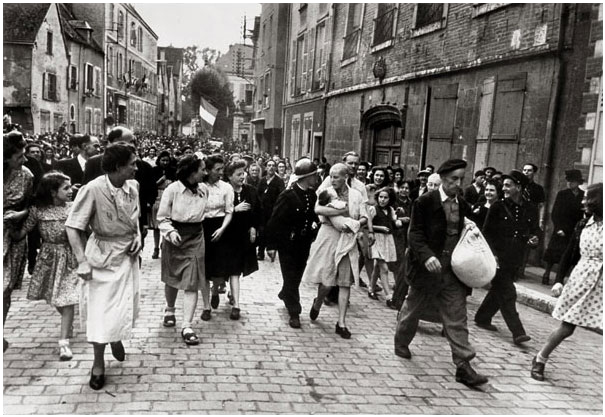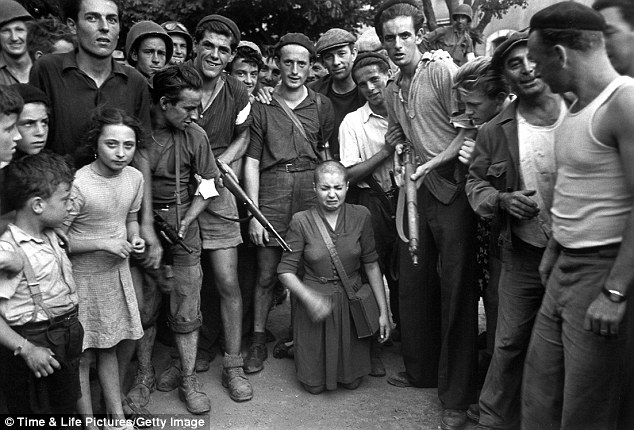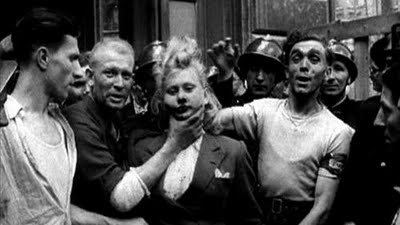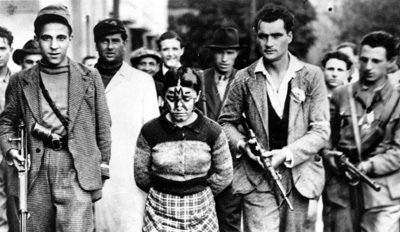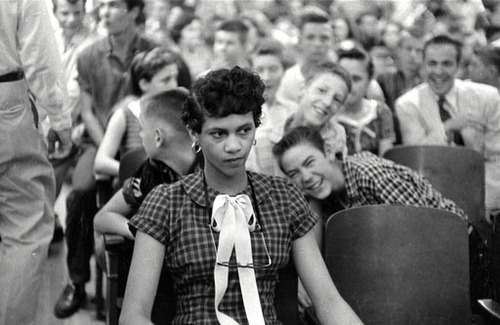Crowds #6: Bully Crowds November 19, 2012
Author: Beach Combing | in : Contemporary , trackbackWe have so far shown numerous posts on crowd photographs: crowd art, crowd speeches, August 1914 crowds, POWs in crowds and religious crowds. Here is by far the most unpleasant of the series – you have been warned! – bullying crowds. A group of people with power, perhaps newly acquired power, decides to revenge itself on an ‘enemy’ in its midst. Sometimes these ‘enemies’ have done great damage to the community: more typically they are symbolic and soft targets.
What is striking in these images isn’t the fear, which is well-founded, but the ghastly enjoyment on the faces of those doing the bullying. The most famous bullying crowd pictures come from France and Italy at Liberation where local population’s wreaked vengeance on those who had or were believed to have collaborated: interesting that Holland and Denmark declined, for the most part, to follow this tradition. The brunt was taken by women who had had ‘horizontal’ relations with Germans: the French woman being run out town above has a newborn in her arms, a child born of a union with a German soldier. We started with this relatively low-grade photograph to give any sensitive readers the chance to remove themselves from this page. The following are still worse:
This photo shows a woman in a village near Marseille being humiliated by her neighbours: in many of the photographs the crowd are people who knew the victim. The neighbourly bonds that should have stopped this beastliness seem, instead, to have awoken the brute gorilla that is there in all of us. Grown adults acted like cruel schoolchildren. This was truly a community event: it even had to be photographed and commemorated.
Some historians have suggested – there is a surprising amount of literature on this question – that by concentrating on ‘love’ traitors, the French, particularly, avoided a civil war and channeled aggression into a ‘comparatively harmless act’ [sic] of shaving. In some cases, though women were killed. Pictured here is Marcelle Polge (Nimes) who had, it was claimed, had sexual relations with a German officer. She was shot after being publicly humiliated: the ‘Court Martial’ she was put through had nothing to do with justice.
And below there is a photograph from Milan. How old was this girl? Shamefully the picture appears, with celebratory comments on some Italian partisan sites to this day. Note the M for Mussolini painted on to her face… In the end these photographs are less deadly than those horrific images from the eastern front of SS (or other monsters from the German military and their allies) murdering Jews. But their effect is, at least for Beach, more ghastly simply because (i) most of us couldn’t kill but most of us could do this and (ii) because of the grins, which are rare in einsatzgruppen photographs, but which ultimately lead to the death of innocents.
Of course, bully crowds can be found throughout history. We don’t have photographs from the burning years, but here are some impressions that bring us close to the duckings that accompanied popular suspicions about this or that local strix: the community’s presence was fundamental. Experts in witchcraft could probably learn something from the revenge attacks in small villages after the last world war. [the Count points out, see below, that the first picture shows ducking not a swimming: apologies]
Then another source of bully photographs is the struggle for civil rights in the southern states.
In 1963 some sitter-inners have ketchup, coffee and the like poured on them in Jackson, Mississipi. And even more disturbing here is a shot from Dorothy Counts first day at Harry Harding High School in North Carolina. She was fifteen and against all the odds lasted almost a week before her parents removed her. Every day when she came home her back was covered in spit.
Beach finishes with this link to the story of Amanda Todd, a Canadian teen who committed suicide last month. The story is heartbreaking. Other bully photographs: drbeachcombing AT yahoo DOT com
***
20 Nov 2012: Louis writes in: Unfortunately your positive assessment of the Netherlands is not correct: two photographs, blackened face and shaving a collaborator Even in the movie “Soldier of Orange”(or at least in the TV series) there is a scene in which a girl is being shorn, for “colaborating” with the germans. Not our proudest moment, as Dutchmen…’ Thanks Louis.
21 Nov 2012: The Count writes: ‘the first of your two illustrations of “witch-ducking” doesn’t show a witch at all. Ducking-stools, which, as you can see from the picture, were quite large and elaborate things to set up just to see if an old lady could float. They were in fact used to punish women who were judged to be unsatisfactory wives, usually for nagging their husbands, or otherwise being insufficiently submissive. Of course, a large part of the punishment was the public humiliation. The purpose of building that huge, costly device was partly a controlled way of throwing women in the river with no risk of their being swept away and drowned, but mainly to provide a constantly visible reminder to behave yourself, just like the stocks and the gibbet. Some further examples thereof… For parishes with a smaller budget, devices such as the scold’s bridle served a similar function. Aren’t people nice? The second illustration, on the other hand, certainly does show a witch being “swum”. Actually that’s a bit of a misnomer, since the whole point was that she didn’t swim at all. The logic behind it was that since a witch has renounced her baptism, and baptism involves water, henceforth water will reject her, so anyone who can’t sink must be a witch (presumably it never occurred to them that the all-time champion at not sinking in water was a chap called Jesus Christ). If you closely at that picture, you can see all the elements in the process. The suspect was always immobilized in some way – in this instance, the supposed witches appear to be wrapped in sheets by way of an improvised strait-jacket – because even people whose life depends on not floating may panic and attempt to stay afloat by swimming. Suspects were also stripped of all clothing except that required to preserve modesty, to make sure no air was trapped in their clothes to buoy them up. In its own bonkers way, it was all surprisingly fair. Note the people on the right taking the strain on ropes. Contrary to popular belief, the poor girl didn’t have to go right to the bottom and drown in order to establish her innocence. She just had to indubitably disappear below the surface for a moment or two, and then they’d haul her out in a matter of seconds. And see that guy in the pond with her? He’s prodding her with a stick to help her go under if she’s going to – if she’s a witch, she should be unable to sink even with this kind of assistance. Of course, if the fellow with the stick is one of those demented witch-hunters who think the end justifies the means, he may only be pretending to push her under in order to prove her guilt all the more convincingly when he claims he can’t manage it. On the other hand, if the case was a controversial one, the suspect might have quite a crowd of friends and family prodding her with poles. Since under these circumstances it’s more or less physically impossible not to sink, suspected witches whose guilt was very doubtful had a bit of an edge. Really, rather than bullying, this weird ritual was mainly a means of providing what we would nowadays call “closure”. Once the rumours started, they’d never go away until the question was settled one way or another, and “swimming”, though unpleasant, quickly decided the issue once and for all, and it was much easier to pass the test than to fail, especially if you had friends who were willing to help. Probably the reason it ceased to be part of the official judicial process very early on was that if it was admitted to be a valid test, they’d have had to acquit the vast majority of their suspects before the trial even started, and it would have begun to dawn on people that the whole witch thing was maybe a bit silly. It’s also worth bearing in mind that, except in the middle of a full-blown witch-panic where just about anybody might be accused, people rumoured to be witches had usually made themselves unpopular in some way. So even if they passed, the test was itself a public humiliation that reminded them to behave themselves in future. Another, more obscure test involved weighing the suspect on a huge pair of scales against the church Bible. If this brings to mind a certain movie scene involving a duck, that’s because Terry Jones, a genuine mediaeval scholar when he isn’t being professionally silly, undoubtedly knew of this weird procedure. The idea was that obviously, although the Bible used was a really big, heavy book, it couldn’t possibly weigh more than a human being who wasn’t three days old or the world’s tiniest midget. However, it contained the “weight” of God’s grace, and, this being entirely absent from a witch who had renounced her baptism, it would magically weigh more than she did. This seems to have been used in cases where the local bigwigs knew perfectly well that the suspect was the victim of malicious gossip, and wanted to allow her a chance to prove her innocence in a way that didn’t involve any indignities being heaped upon her, and which moreover she couldn’t possibly fail, except through a literal Act Of God. I assume they stopped using this one because people began to question the validity of a test which had never detected any witches at all. Unfortunately they didn’t follow that thought to its logical conclusion and realise that there weren’t really any witches to detect.’ Thanks Count, particularly for the correction!

